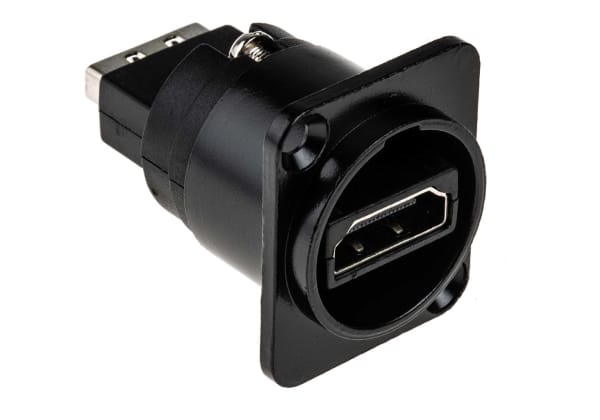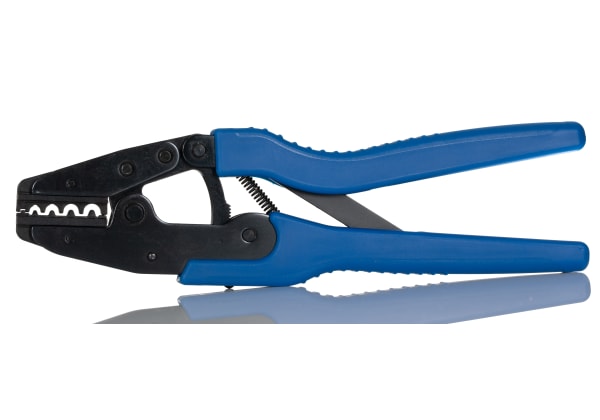- Published 24 Jan 2023
- Last Modified 29 Aug 2023
- 8 min
A Complete Guide to RCA Connectors
Our guide shares the different uses and applications of RCA connectors and explores the best products available.

Reviewed by Stephen Bettles, Technical Support Engineer (April 2021)
In this guide to RCA connectors, we will answer questions including ‘what are RCA cables?’, ‘what are the different types of RCA connectors for?’, and ‘what’s the best RCA connector for my setup?’.
We will start by outlining the basic uses of RCA jacks, and then explore some of the most common types of A/V connectors you can buy online.
What are RCA Connectors?
RCA connectors are a type of audiovisual or A/V connector. A/V stands for audio/video. They are sometimes called audio jacks or phono connectors (as in phonograph), as they are typically associated with analogue audio cables. In practice, though, they can be used to transmit several types of signals. These include:
- Analogue audio
- Digital audio
- Component analogue video
- Composite analogue video
The name RCA is an acronym for the Radio Corporation of America, which originally designed the system in the 1930s. The term RCA connector can refer either to the plug on the end of an RCA cable (A/V audio cables) or to the socket you insert these into on a device. In other words, they can be male or female. Most people use the terms jack and plug to help differentiate.
There are various sorts of RCA connectors for sale in the UK, with each type having its own specific uses. They are most often chosen for applications where analogue stereo A/V signals need to be sent separately between devices at the same time.
An RCA cable may therefore have either two or three plugs on it - two for left and right audio, and sometimes a third for video. These are typically colour-coded as follows:
- White for audio left
- Red for audio right
- Yellow for video
RCA Connector Uses

An RCA or phono connector can carry both audio and video signals. The audio it carries can either be analogue or digital, depending on the type of cables and devices being used. RCA plugs are the metal connectors on the end of an RCA cable, while RCA sockets are found on the body of the device that is being plugged in. In common use, a jack normally means a female socket, while a plug indicates a male cable termination.
Most people buy RCA connectors to hook up audio equipment or audio-video systems. RCA connectors are widely used for carrying a signal to many types of electrical hardware and devices. You will usually find them on a wide range of devices such as amplifiers, portable music players, TVs, speakers and Hi-Fi equipment, and headphones.
Jacks provide either an input or an output, for signals being sent to or from another device. These RCA sockets will normally be labelled input or output accordingly. Input means they will be receiving a signal from another device, while output means they are sending an audio or video signal elsewhere.
RCA Connectors for Speakers
RCA connectors for speaker wire are among the most common types. They are usually arranged to provide a 2-channel or stereo audio input/output signal. This means you will typically find two jacks or plugs next to each other - one for left audio, and one for right audio.
As noted above, the connector (or, less often, the RCA cable itself) for the right audio is normally colour-coded red, while the left audio is usually white. Where colour-coding is not used, the plugs or jacks will almost always be marked with an L and R to indicate which is which.
In some cases, you may be able to swap them around without causing any real problems, provided you do not cross over between one device and another. If L is plugged into R, it needs to be that way at both device ends of the cable. However, to avoid any potential signal or audio quality problems, it is always best to pay attention to the correct L-R orientation.
Types of RCA Connectors
There are numerous different types of RCA connectors widely available. Most tend to be bought for attaching to coaxial cables, resulting in an RCA cable. Other terms you might use to find these types of products include RCA jacks, phono sockets, A/V plugs, audio jacks, and audio components.
RCA Connectors for Coaxial Cables
Coaxial cable is typically used for digital A/V inputs and outputs and normally requires just a single connection. Since it is a connection meant for a digital audio signal, it only requires one cable, unlike analogue stereo audio. These cables and inputs can support surround sound, such as Dolby Digital 2.0/5.1 signals, and uncompressed PCM stereo audio.
Many devices provide a jack that can be plugged into a male coaxial cable RCA connector. This will normally be a single female RCA connector, often colour-coded in either black or orange. Some of these connectors may not specify coaxial but rather digital out/digital in.
Audio RCA Connectors
Audio RCA connectors are one of the most familiar types. You will often find them on the back of an amplifier, speakers, TVs, and headphones. They come in various physical configurations.

Right-Angle RCA Connectors
Right-angle RCA connectors can be handy when a cable needs to terminate with a socket in a tight space, such as under a table or flush against a wall. The 90-degree angle of the plug moulding means it requires less clearance at the back and is, therefore, less likely to get damaged through being pressed and bent against obstacles.
Right-angled RCA plugs and jacks are also useful in various specialist applications, such as when a connector needs to be directly PCB mounted.

Straight RCA Connectors
Straight RCA connectors are the standard body type for A/V plugs and sockets. The male plug continues in the same direction as the cable it is attached to and attaches in-line to the female socket. This can require a little more clearance space, as the resulting coupling will tend to stand prouder of the socket, although they are typically among the easiest connector shapes to plug in and remove repeatedly.

Male RCA Connectors
Male RCA connectors are the plugs on the ends of RCA cables, and as such are almost always classed as cable mount RCA connectors.
They are available in a wide range of termination methods. Some of the most common include clamp/crimp, feed through, pin, PC pin, and soldered RCA connections.
You can also choose from a broad array of other male RCA plug options, including contact plating and housing materials, current ratings/voltage ratings, and min/max operating temperatures. Among the more common materials used for plating RCA contacts are gold, nickel, silver, and tin.

Female RCA Connectors
Female RCA connectors are recessed jacks or sockets designed to accept a male plug. They are located on the body of the device or hardware being connected, typically as part of the rear I/O (input/output) array. They will usually be labelled for input or output, and often colour coded or marked with L and R.
Female connectors and phono sockets are widely sold with numerous options for mounting types. The most common RCA jack mounting types are generally:
- Chassis mount RCA connectors - designed to be inserted directly into a suitable recess in the outer body of a device
- Panel mount RCA connectors - includes additional fixing points allowing it to be installed on an instrument panel or equipment panel, as well as in an enclosure
- PCB mount RCA connectors - intended for mounting directly to the surface of a printed circuit board, often forming part of an I/O array (e.g. on computer motherboards)
- Snap-in RCA connectors or screw-in solderless RCA connectors - an easy way to add an RCA connection bulkhead to a suitable A/V faceplate, surface mount box, keystone wall plate, or patch panel
FAQs
How Do You Crimp an RCA Connector?
To crimp an RCA connector to a suitable cable, you will first need to remove the old connector and strip the cable a short way back from the termination point, to expose some of the inner wires behind the audio cable shielding. You will also need a cable crimping tool kit to reattach a new plug.
The process of performing a cable crimp is straightforward and involves:
- Inserting the new RCA terminal into the crimping tool
- Inserting the cable wires into the terminal
- Squeezing the handles of the crimping tool together to cold weld the terminal onto the wires
However, you will need to be aware of some other important variables depending on the specific type, make and model of your RCA connector. Different configurations and termination methods may involve rings, spades, butt splice terminals, and insulated or non-insulated terminals. Your crimp tool instruction manual will help you recognise and adjust for the specific terminal and type of connection you want to make.
Why Do I Hear a Buzz When I Couple an RCA Connector to a Speaker?
You can recognise a male RCA plug by the protruding pin encircled by a raised ring. The corresponding female RCA jack or socket has a hole in the centre of a corresponding ring.
When inserting a plug into a jack, both rings must be pushed fully together until they are completely touching all the way around (metal to metal contact). Failure to do this will usually result in a buzzing sound, indicating that the connection is not properly grounded.
Best RCA Connectors to Buy
Some of the most popular manufacturers for RCA connectors include Deltron, Keystone, Lumberg, Neutrik, and Switchcraft. We work with all these quality brands to supply our range of RCA plugs and jacks.
We also offer our in-house range of RS PRO A/V connectors, made to the same high standards we request from our partner brands to give you the products of the quality you expect from RS.
Where to Next?
Related links
- AV Adapters
- RS PRO Male RCA x 2 to Male 3.5mm Stereo Jack RCA Cable 1.5m
- RS PRO Male RCA x 2 to Male 3.5mm Stereo Jack Aux Cable 1m
- RS PRO Male RCA x 2 to Male 3.5mm Stereo Jack RCA Cable 500mm
- RS PRO Male RCA x 2 to Male 3.5mm Stereo Jack RCA Cable 1.2m
- RS PRO Male RCA x 2 to Male 3.5mm Stereo Jack RCA Cable 5m
- RS PRO Male RCA x 2 to Male 3.5mm Stereo Jack RCA Cable 10m
- RS PRO Male RCA x 2 to Male 3.5mm Stereo Jack RCA Cable 20m




